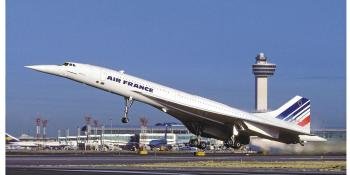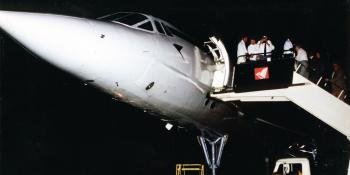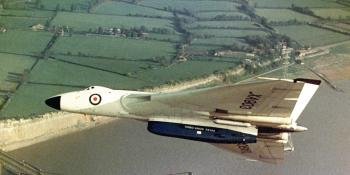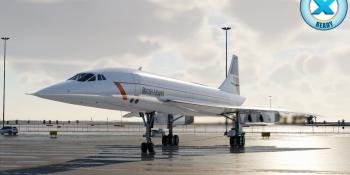Concorde
Concorde first took to the skies on March 2, 1968, and supersonic services by Air France and British Airways commenced on the same day in 1976 – January 21. The crash of an Air France Concorde on July 25, 2000, led to both airlines’ fleets being grounded until modifications were made. Passenger services re-started on November 7, 2001, however, this was short-lived. Air France flew its final Concorde passenger flights on May 31, 2003, while for British Airways it was October 24 that same year that it retired the legendary aircraft.
Before Concorde, in order to travel at Mach 2 you had to wear a G-suit, breathe through an oxygen mask and sit on a seat that could eject you out of the aircraft in fractions of a second. All that changed when the first (and only) supersonic airliner took to the skies. Now the cities of London and New York were separated by a mere three hours flying time… whilst sipping on your glass of champagne. Even now that seems like the stuff of dreams, but that was the futuristic reality of Concorde. To make this possible every aspect of the aircraft was designed for aerodynamic efficiency, and yet the outcome became something truly elegant, an icon of beauty. Sadly, the world is a bigger place now that its skies no longer echo to the roar of Concorde.
An engineering masterpiece, Concorde had a maximum speed of over twice the speed of sound at Mach 2.04 (1,354mph or 2,180 km/h at cruise altitude), with seating for 92 to 128 passengers.
Concorde development
This unrivalled aircraft was the result of a collaborative venture between the aviation industries of Britain and France and dated back to design work for a supersonic transport (SST) carried out by Sud Aviation and Bristol. The forecast high costs of any SST program and the similarities in the designs led to a 1962 government agreement between France and Britain which resulted in the British Aircraft Corporation (into which Bristol had been merged) and Sud Aviation (which became a part of Aerospatiale in 1970) joining to design and develop such an aircraft. Talks with airlines in the 1960s resulted in a relatively long-range aircraft design capable of flying transatlantic sectors. Famously, the design of the airframe was refined to feature a highly complex delta wing featuring cambering and ogival leading edges with pairs of afterburning engines mounted in pods under the wing. The slender fuselage featured a high fineness ratio to keep supersonic drag to a minimum, while the fuel system was designed to trim the aircraft longitudinally by transferring fuel between tanks to combat the change in the centre of pressure as the aircraft accelerates. The aircraft used reheat (afterburners) at take-off and to pass through the upper transonic regime and to supersonic speeds, between Mach 0.95 and Mach 1.7.
How Concorde’s nose worked
Another feature was the variable geometry nose which was lowered while taxying, on take-off and landing to improve the flightcrew's visibility. Owing to air compression in front of Concorde as it travelled at supersonic speed, the fuselage heated up and expanded by almost 1ft (300mm). Most its surface also had to be covered with a highly reflective white paint to avoid overheating the aluminium structure due to heating effects from supersonic flight at Mach 2. A lengthy development programme following the Concorde's first flight on 2 March 1969 meant that it did not enter airline service until January 1976. Twenty aircraft were built, including six prototypes and development aircraft.
Which airlines purchased Concorde?
Air France and British Airways were the only airlines to purchase and fly Concorde. The aircraft was primarily used by wealthy passengers who could afford to pay a high price in exchange for Concorde's speed and luxury service. Among other destinations, Concorde flew regular transatlantic flights from London's Heathrow Airport and Paris's Charles de Gaulle Airport to John F. Kennedy International Airport in New York, Washington Dulles International Airport and Grantley Adams International Airport in Barbados; it flew these routes in less than half the time of other airliners.
Concorde retirement
The type was retired in 2003, three years after the crash of Air France Flight 4590, in which all passengers and crew were killed. The general downturn in the commercial aviation industry after the 11 September attacks in 2001 and the end of maintenance support for Concorde by Airbus (the successor company of both Aérospatiale and BAC) also contributed. In her 27 years of passenger service, over 2.5 million people flew on Concorde.
With the skies now devoid of the world’s most beautiful airliner, the domain of flying at Mach 2 has once again returned to the elite few wearing military flying suits.
The need for speed
The fastest transatlantic airliner flight was from New York JFK to London Heathrow on 7 February 1996 by British Airways Concorde G-BOAD in 2hrs 53min, from take-off to touchdown aided by a 175mph (282km/h) tailwind. On 13 February 1985, a Concorde charter flight flew from London Heathrow to Sydney in a time of 17hrs 4min, including refuelling stops. Concorde also set other records, including the official FAI ‘Westbound Around the World’ and ‘Eastbound Around the World’ air speed records.
Aerospatiale/BAC Concorde Specifications
| Maximum speed | Mach 2.4 (1,354mph/2,179km/h) |
| Capacity | 92-120 passengers |
| Engines | 4 x Rolls-Royce/Snecma Olympus 592 turbojets |
| Power | Each 32,000lb dry thrust, 38,050lb in afterburner |
| Wingspan | 84ft (25.6m) |
| Length | 202ft 4in (61.66m) |
| Height | 40ft (12.2m) |
| Ceiling | 60,000ft (18,300m) |
| Range | 4,488 miles (7,222km) |









